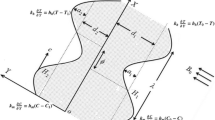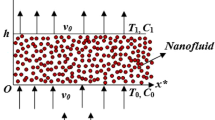Abstract
The current study aims to scrutinize the peristalsis of magnetohydrodynamics Reiner-Rivlin fluid model in a cylindrical tube through porous medium. The basic equations, including momentum, heat, and concentration are tackled in the valuable presence of Hall current, Joule heating, viscous-dissipation, and Soret effects. Moreover, slip effect is also entertained. The considered system is simplified by approximating with long wavelengths and very low Reynolds numbers. Perturbation technique is chosen to obtain the closed form analytical solutions. The impact of influential parameters is presented through plots and physically discussed in detail. The main conclusions of this work are that the velocity and temperature fields exhibit opposite behavior for the Hartman number and Hall parameter. The slip parameter has minimizing impact on velocity distribution. The fluid velocity tends to increase when Reiner-Rivlin fluid parameter is incremented. The Darcy number has upgrading impact on fluid temperature. The solute concentration minifies when slip parameter is incremented. It can be visualized that size of trapped bolus becomes larger on increasing the value of Hall and slip parameter. This research investigation basically examine the blood flow through an artery under strong electric and magnetic field effects. Therefore, this study laid the ground work for scientists, engineers, and medical practitioners working in physiological field.








Similar content being viewed by others
Data availability
The data used to support the findings of this study are included within the article.
Abbreviations
- \(\overline{\user2{V}} = \left( {u\left( {r,z,t} \right),0,w\left( {r,z,t} \right)} \right)\) :
-
Velocity vector
- \({\varvec{J}} = \frac{A}{{m^{2} }}\) :
-
Current density
- \(\sigma = \frac{S}{m}\) :
-
Electric conductivity
- \(m = \left( {\frac{{\sigma B_{0} }}{{en_{e} }}} \right)\) :
-
Hall effect
- \(\tau_{ij}\) :
-
Cauchy stress tensor
- \(\theta\) :
-
Temperature in dimensionless form
- (\(T_{0} ,T_{1} )\) :
-
Temperature at lower and upper wall, respectively
- \(Q\) :
-
Volume flow rate
- \(\delta_{ij}\) :
-
Kronecker delta
- \(e_{ij}\) :
-
Strain tensor rate
- \(\mu_{c}\) :
-
Cross viscosity parameter
- \(k\) :
-
Permeability parameter
- \(\rho = \frac{{{\text{kg}}}}{{{\text{m}}^{3} }}\) :
-
Fluid density
- \({\text{Sr}} = \left( {\frac{{\rho \left( {T_{1} - T_{0} } \right)DK_{T} }}{{\mu T_{m} \left( {C_{1} - C_{0} } \right)}}} \right)\) :
-
Soret number
- \(\mu\) :
-
Fluid viscosity
- \(\rho C_{{\text{p}}}\) :
-
Specific heat constant
- \(D_{{\text{m}}}\) :
-
Diffusion constant
- \(T_{{\text{m}}}\) :
-
Mean temperature
- \(\kappa = \frac{{\text{W}}}{{{\text{m}}.{\text{k}}}}\) :
-
Thermal conductivity
- \(\left( {\beta ,\beta_{1} ,\beta_{2} } \right)\) :
-
Slip parameters
- \(\phi\) :
-
Concentration in dimensionless form
- \(\left( {C_{0} ,C_{1} } \right)\) :
-
Concentration at lower and upper wall, respectively
- \(B = \left( {0,0,B_{0} } \right)\) :
-
Magnetic field
- \(\delta = \left( {\frac{d}{\lambda }} \right)\) :
-
Wave number
- \({\text{Re}} = \frac{\rho cd}{\mu }\) :
-
Reynolds number
- \(\lambda = \frac{{\overline{\mu }_{{\text{c}}} c}}{\mu d}\) :
-
Fluid parameter
- \(M^{2} = \frac{{\sigma B_{0}^{2} d^{2} }}{\mu }\) :
-
Hartmann number
- \(D_{{\text{a}}} = \frac{{k_{0} }}{{d^{2} }}\) :
-
Darcy resistance parameter
- \({\text{Pr}} = \left( {\frac{{\mu C_{{\text{p}}} }}{\kappa }} \right)\) :
-
Prandtl number
- \({\text{Sc}} = \left( {\frac{\mu }{\rho D}} \right)\) :
-
Schmidt number
References
Abd-Alla AM, Abo-Dahab SM (2015) Magnetic field and rotation effects on peristaltic transport of a Jeffrey fluid in an asymmetric channel. J Magn Mag Mater 374:680–689
Akbar NS, Nadeem S (2010) Simulation of heat and chemical reactions on Reiner Rivlin fluid model for blood flow through tapered artery with stenosis. Heat Mass Trans 46:531–539
Akbar NS, Nadeem S, Mekheimer KhS (2016) Rheological properties of Reiner Rivlin fluid model for blood flow through tapered artery with stenosis. J Egyp Mathe Soc 24:138–142
Alsaedi A, Nisar Z, Hayat T, Ahmad B (2021) Analysis of mixed convection and Hall current for MHD peristaltic transport of nanofluid with complaint wall. Inter Comm Heat Mass Trans 121:105121
Asghar Z (2023) Enhancing motility of micro-swimmers via electric and dynamical interactions effects. Euro Phys J plus. https://doi.org/10.1140/epjp/s13360-023-03963-w
Asghar Z, Ali N, Javid K, Waqas M, Khan WA (2021) Dynamical interaction effects on soft-bodied organisms in a multi-sinusoidal passage. Eur Phys J plus 693:10. https://doi.org/10.1140/epjp/s13360-021-01669-5
Asghar Z, Waqas M, Gondal MA, Khan WA (2022) Electro-osmotically driven generalized Newtonian blood flow in a divergent micro-channel. Alex Eng J 61:4519–4528
Asghar Z, Khan MWS, Gondal MA, Ghaffari A (2023) Magnet hydrodynamic flow of Carreau Yasuda fluid inside a complex wavy passage formed by beating cilia. Proc Inst Mech Eng Part E. https://doi.org/10.1177/09544089231171037
Attia HA (2007) The effect of ion slip on the flow of Reiner Rivlin fluid due to rotating disk with heat transfer. J Mech Sci Tech 43:174–183
Burns JC, Parkes T (1967) Peristaltic motion. J Fluid Mech 29:731–743
El Shehawey EF, El Sebaei W (2000) Peristaltic transport in a cylindrical tube through a porous medium. Inter J Math Mathe Sci 24:265874
Eldabe NT, Elogail MA, Elshaboury SM, Hasan AA (2016) Hall effects on the peristaltic transport of Williamson fluid through a porous medium with heat and mass trans. App Math Mod 40:315–328
Forbes LK (2018) Steady flow of Reiner Rivlin fluid between rotating plates. Phys Fluids 30:103104
Fung YC, Yin F (1968) Peristaltic transport. J App Mech 35:669–675
Gad NS (2014) Effects of Hall currents on peristaltic transport with complaint walls. Appl Math Comp 235:546–554
Hasan MM, Samad MA, Hossain MM (2020) Effects of Hall current and Ohmic heating on non-Newtonian fluid flow in a channel due to peristaltic wave. App Mathe 11:292–306
Hayat T, Shafique M, Tanveer A, Alsaedi A (2017) Slip and joule heating effects on radiative peristaltic flow of hyperbolic tangent nano-fluid. J Heat Mass Transf 112:559–567
Hayat T, Nisar Z, Alsaedi A (2020) Impacts of slip in radiative MHD peristaltic flow of fourth-grade nanomaterial with chemical reaction. Int Comm Heat Mass Transf 119:104976
Hina S, Yasin M (2018) Slip effects on peristaltic flow of magnetohydrodynamics second grade fluid through a flexible channel with heat/mass transfer. J Thermal Sci Eng App 10:051002
Hina S, Hayat T, Alsaedi A (2013) Slip effects on MHD peristaltic motion with heat and mass transfer. Arab J Sci Eng 39:593–603
Javid K, Ali N, Khan S (2019) Numerical study of Hall effects on the peristaltically induced motion of a viscous fluid through a non-uniform regime: an application to the medical science. Eur Phys J plus 134:395
Khabazi NP, Taghavi SM, Sadegy K (2016) The peristaltic flow of Bingham fluid at large Reynolds number: a numerical study. J Non Newton Fluid Mech 227:20–34
Kothandapani M, Srinivas S (2008) On the influence of wall properties in the MHD peristaltic transport with heat transfer and porous medium. Phys Lett A 372:4586–4591
Kothandapani M, Prakash J, Srinivas S (2015) Peristaltic transport of a MHD Carreau fluid in a tapered asymmetric channel with permeable walls. Int J Biomathe 8:1550054
Latham TW (1966) Fluid motion in peristaltic pumps. MS. Thesis, MIT, Cambridge, MA
Noreen S, Kausar K (2019) Hall, slip and Ohmic heating effects in the thermally active sinusoidal channel. Prop Power Res 8:263–273
Rafiq T, Mustafa M, Ahmad J (2022) Rotationally symmetric flow of Reiner Rivlin fluid over heated porous wall using numerical approach. Pro Inst Mech Eng J Mech Eng Sci 236:2803–2814
Rani J, Hina S, Mustafa M (2020) A novel formulation for MHD slip flow of Elastico-viscous fluid induced by peristaltic waves with heat/Mass transfer effects. Arab J Sci Eng 45:9213–9225
Rathod VP, Channakote MM (2011) A study of ureteral peristalsis in cylindrical tube through porous medium. Adv Appl Sci Res 2:134–140
Reiner M (1945) A mathematical theory of dilatancy. Am J Math Soc 67:350–362
Rivlin RS (1948) The hydrodynamics of non-Newtonian fluids. I Proc Roy Soc Lond A 193:260–281
Srinivas S, Muthuraj R (2011) Effects of chemical reactions and space porosity on MHD mixed convective flow in a vertical asymmetric channel with peristalsis. Math Comp Mod 54:1213–1227
Funding
The authors received no financial support for this research and for publication of this article.
Author information
Authors and Affiliations
Corresponding author
Ethics declarations
Conflict of interest
The authors have no conflict of interest.
Additional information
Publisher's Note
Springer Nature remains neutral with regard to jurisdictional claims in published maps and institutional affiliations.
Appendix
Appendix
Rights and permissions
Springer Nature or its licensor (e.g. a society or other partner) holds exclusive rights to this article under a publishing agreement with the author(s) or other rightsholder(s); author self-archiving of the accepted manuscript version of this article is solely governed by the terms of such publishing agreement and applicable law.
About this article
Cite this article
Yasin, M., Hina, S. & Naz, R. Influence of Hall and Slip on MHD Reiner-Rivlin blood flow through a porous medium in a cylindrical tube. Soft Comput 28, 2799–2810 (2024). https://doi.org/10.1007/s00500-023-09538-2
Accepted:
Published:
Issue Date:
DOI: https://doi.org/10.1007/s00500-023-09538-2




